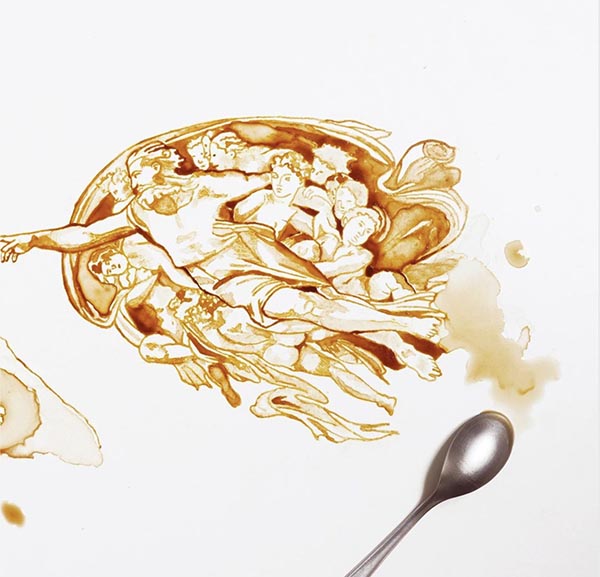seems a bit weird to always give the miss universe title to an earthling
— ????Imani Gandy Cane???? (@AngryBlackLady) December 13, 2021
A Head for Folding
In The Guardian this week was a story about Mary, Queen of Scots who, on February 8, 1587, the eve of her execution, wrote a letter to Henry III, the king of France. It was essentially her last will and testament, as well as an attempt to secure a martyrdom. As a result, she didn’t want the letter opened by anyone other than the intended recipient or, if it was, that tampering would be evident. This was before user IDs and passwords so she used a complex folding process called “letterlocking.”
“One of the most spectacular examples of spiral locking … is Mary’s last letter,” they write in an article which was published on Friday in the Electronic British Library Journal.
… The spiral lock requires more than 30 steps to complete, a mix of folding and slits and sometimes adhesive, to prevent unwanted readings. It is, they say, “a highly intricate technique that required time, patience and great skill: one wrong move and your locking mechanism could break and you would have to start the letter again.
“The mechanics of this lock force the person opening the letter to tear the lock apart in order to access the contents,” write the academics. “Because the lock breaks in multiple places, it is impossible to piece back together in a way that would allow it to pass through the slits again; if someone thought their correspondence had been tampered with, it would be relatively simple to detect.”
“Letterlocking is one of the most important communication techniques the world has known, but its history is only just coming to light,” said Smith. “For some 600 years, virtually all letters were sent using letterlocking, before the invention of the modern gummed envelope in the 19th century – it was as important to epistolary communication as computer coding is to emails today. The study of letterlocking supplies us with rich information about the concern historical figures had with communication security, and it also testifies to the inventiveness and even aesthetic creativity with which they responded to these concerns. The fantastically intricate spiral lock brings all these aspects together.”
Checkmate
Who do I sue? https://t.co/fTtgRdNk7z pic.twitter.com/THPYkDXzxd
— Phil Wang (@PhilNWang) December 13, 2021
The Devil Wears Graphene
Was it a good week for graphene news? It’s always a good week for graphene news! Says Graphene-Info: “AspenX, a premium retail brand recently launched by the Aspen Skiing Company, has collaborated with Prada on a graphene-enhanced capsule collection.”
The six-piece range of performance outerwear mixes Prada Linea Rosso’s Extreme-Tex waterproof layer with a graphene padding to regulate body temperature, and distinctive graphic black-and-white designs by artist Paula Crown.
Might be worth looking into.
There line includes two men’s jackets, two women’s jackets and two sweatshirt styles, priced from $1,970 to $5,400.
(Does spit take with coffee.) Well, maybe not.
Built to Spill
After we did out coffee spit take above, we had to clean it up. Or did we?
Sometimes inspiration can strike at the oddest moment, such as when someone has spilled a cup of coffee. Take, for example, artist Giulia Bernardelli. An accident, one we have likely all experienced at some point (or many points), led to a whole new creative endeavor. Via Laughing Squid:
One day i was drawing and having my coffee at the same time. Suddenly i moved my hand too quickly and tipped over my cup. The natural coffee stain inspired me, so i picked up the spoon and made it my brush.
Et voilà: coffee spill art.

She has also dabbled in other media, such as chocolate and red wine. So the next time you spill some milk, don’t cry…draw!
Signs of the Times: A Compendium
Street signs you just have to see to believe
— DailyStuff (@DailyStuffMag) December 11, 2021
In a Bind
Consider the binder clip. It’s a stationery item that has endured and few of us have ever had any particular thoughts about its design. However, even when one is not arthritic, binder clips can be a challenge to open, especially when trying to clip large sheafs of paper, which some of us still do occasionally have to do. So Plus Corporation, an office supplies manufacturing company in Japan, a country with an aging population, has taken a long look at the binder clip, and done a redesign to make it easier to open. Says Core77:
They've embossed in a new fulcrum at a lower point in the body of the spring, whereas the standard design simply uses the corner of the spring itself as the fulcrum. This new fulcrum location, along with the slightly increased handle length, provides better leverage.
Additionally, they've changed the shape of the wire handles to provide greater contact area for the fingers.

Plus Corporation reckons they've cut the effort required to open the clip by 50%.
The Air Karu clips come in seven sizes, from the 200-page-capacity Jumbo size to a 30-page-capacity Micro.
Polka Your Eyes Out
FYI, we're a sensitive lot. https://t.co/t6l1T4pj9y
— Al Yankovic (@alyankovic) December 11, 2021
Toast Is the Most
Nowadays, we consider an appliance “smart” if it connects to the Internet. (Well, we don’t; hardcore technology proponents do.) However, The Verge—not exactly technology opponents, after all—recently cited a Sunbeam toaster that debuted in 1949 as “smarter than any sold today.”
That’s because in 1948, Sunbeam engineer Ludvik J. Koci invented the perfect toaster, one where the simple act of placing a slice into one of its two slots would result in a delicious piece of toasted bread. No button, no lever, no other input required. Drop bread, get toast.
… When you stick a piece of bread into this toaster, it pushes down a series of cleverly designed levers that have just enough tension to lower and raise two slices all by themselves — and it’s got a mechanical thermostat inside that stops your bread toasting when it’s toasted and ready, NOT after some arbitrary amount of time.
With the Sunbeam, the heat radiating from the bread itself warms up a bimetal strip (one of the simplest kinds of thermostats) which, being made of two different kinds of metal that expand at different rates, ends up bending backwards to sever the connection and stop the flow of electricity when the toast is done. And here’s the most ingenious part: when the heating wire shrinks as it cools down, that is what triggers the mechanical chain reaction that lifts your bread back up.
If only they still made them, as the current “smart toaster” (in the modern sense of the term) has been described as the point at which the Internet of Things hit “peak stupid.” Besides, the way the IoT seems to be going, once you go down that rabbit hole, you’ll probably end up having to subscribe to a toasting service or the thing will stop working. All praise the Sunbeam!
Fobbing it Off
lol you don't own anything anymore https://t.co/IWTHacfyzx
— Internet of Shit (@internetofshit) December 13, 2021
Cuts Like a [Smart]Knife
If you missed Trish Witkowski’s “Finishing Up the Year” webinar on Wednesday, you missed a great roundup of the latest in binding, finishing, cutting, and embellishment technology and trends. However, the one thing that caught our attention was the IntelliKnife, a “smart knife” (not “smart” in a 1949 toaster kind of way) that has a blade that communicates with the cloud, which sounds like something out of Lord of the Rings or Michael Moorcock’s “Eternal Champion” series.
Anyway, interest piqued, we delved a little further. According to IntelliKnife’s website, the IntelliKnife has an RFID chip embedded in the blade which links to the IntelliKnife app and can give you all sorts of knife performance metrics.
Transparency in your cutting processes!
IntelliKnife enables a full analysis of your process down to each individual cut. Optimise your cutting performance across your organisation, find defects at a glance, improve your production times and much more ...
FEATURES
Individual machine and knife performance at a glance
Possible integration with your company's organisational data collection
Data from all cutting machines in one interface
Supports cutting machines from many manufacturers
Integration possible with your company's CRM
The Writing Life
The arc of the writing life, expressed in a single tweet. https://t.co/R1HRaGYuOD
— J. Michael Straczynski (@straczynski) December 13, 2021
Heads Up!
It’s really only a matter of time before some sort of eyewear becomes de rigueur for computer, phone, or watch displays, Google Glass notwithstanding. An interesting approach, via Core77, is a hybrid monocle/eyeglass system from Chinese smartphone manufacture Oppo. It comes in two parts: a lensless frame—like eyeglass frames—and a removable “bullet” that is attached to a lens and attaches to the frame magnetically. Within the bullet is a microprojector that projects text into the lens. “The sole physical interface is a long silver stripe on the outside of the bullet. This stripe is capacitive, and can be both tapped and swiped.”
The device can be operated via smartphone, smartwatch, voice and gestures:
"OPPO Air Glass can be operated using the Smart Glass App on OPPO Watch 2 and any OPPO smartphone installed with ColorOS 11 or above versions. It also supports four intuitive methods of interaction - touch, voice, hand motions, and head movements.
"When Air Glass is paired with an OPPO Watch 2, users can also use hand movements to confirm, cancel, and switch application cards. Moreover, for a whole new way of interaction, head movements can be recognized by Air Glass, for example gently nodding or shaking the head can open and close notifications respectively."

They tout the display as useful for cycling navigation, real-time translation, and teleprompter capabilities. Hmmm…a glasses-based teleprompter would be perfect for Webinars when you have to read from or heavily refer to notes. We’re not sure why the “bullet” is necessary…why not just have lenses built into the frames like proper glasses? Unless different bullets are required for different applications.
Anyway, we suspect glasses-based displays are a stopgap until a contact lens-based display hits the market.
Not Bob Loblaw
This fellow can become many things I’m sure, but he prob can never name a law firm after himself. pic.twitter.com/77hxeHtvKx
— Preet Bharara (@PreetBharara) October 25, 2021
Investing in Block Chain
As regular readers of Around the Web may have noticed, one site we often check in on is the technology site Gizmodo. At the same time, a site we routinely read for economic commentary is Barry Ritholtz’s The Big Picture. This week, they converged, with Ritholtz doing a reality check on a Gizmodo article, using a phrase that was one of Dr. Joe Webb’s favorites when interpreting printing industry business conditions data: “survivor bias.”
Gizmodo had posted an article pointing out that Legos had become a hot investment, with the headline, “Forget About Gold: Study Says Investing in Lego Sets Will Earn You More Money,” citing a recent study in the January issue of Research in International Business and Finance:
Economists from the Higher School of Economics in Russia have found that the market prices of retired Lego sets sold on the secondary market grow by at least 11% annually, which is higher than the average returns provided by gold, large stocks, bonds, and alternative investments. For their study, the authors analyzed the prices of 2,322 unopened Lego sets from 1987 to 2015 and information about primary sales and online auction transactions.
Ritholtz, who is after all co-founder, chairman, and chief investment officer of Ritholtz Wealth Management LLC, has a well-calibrated BS detector and took issue with the whole “invest in Lego” idea:
But I have to rise to the defense of Gold in this comparison with Legos as an obvious case of Survivorship bias. Nothing is easier than telling you what has already performed well, but without a time machine, we do not get to invest that way. The after the fact review tells us what has already done well, not what is going to do well. The trick in investing is the ability to do that before the asset runs up in price (Duh!).
Not to pick on Gizmodo; references to this study have appeared elsewhere, with varying levels of credulity:
This sort of thing is catnip to media outlets: I first came across this in The Guardian, but it spread from there (Gizmodo, The Hill among others). “Investing in Lego more lucrative than gold, study suggests” is at least a bit circumspect, as opposed to the more conclusive nonsense from HSE University regarding the research paper two of their economists published: “Toys Prove to Be Better Investment Than Gold, Art, and Financial Securities.”
The survivorship bias crew has the unfortunate tendency to over-emphasize big winners while simultaneously excluding big losers. In the investment world, this was first documented with active Mutual funds companies who loved to tout the average returns for their family of funds; somehow, those data tables omitted the funds that had closed primarily because of weak performance.
Why does this matter? Vanguard and DFA (both index shops) found that on average, half of all mutual funds had closed within 15 years. The surviving winners look oh so much better when you back out the long-term returns of the bottom half of all funds, especially when the reason they closed was due to their weak investing results.
And, after all, isn’t a common investment disclaimer “Past performance is no guarantee of future returns” or something like that?
Still, Legos can be fun, regardless of how great an investment they may or may not be.
All Maps Amazing and Terrible, Part the Infinity
Each section contains 10% of the world's population#Map #World #Geography #Cartography #Maps #Mapping #Travel #Population #Earth #Demography pic.twitter.com/AmWTESxSL7
— Amazing Maps™ (@amazingmap) October 24, 2020
The most commonly spoken language other than Spanish by state #Maps #Map #Terriblemaps #TerribleMap #USA #English #spanish #language pic.twitter.com/amnJlaXZyV
— Terrible Maps (@TerribleMaps) June 9, 2020
Why I Otter…
This headline seems like a 2020 throwback: “Otters attack British man in Singapore park.” Says The Guardian:
A man attacked by a pack of otters in a Singapore park has said that he thought he was going to die during the ordeal.
Graham George Spencer, a British citizen living in Singapore, said he was chased, pinned down and bitten “26 times in 10 seconds” by a family of otters while out for an early morning walk in the botanic gardens.
Weirdest reboot of The Birds ever.
Sterne Warning
According to one account, the body of Laurence Sterne, author of Tristram Shandy, was stolen by graverobbers and appeared on a dissection table in Cambridge where it was recognised by the anatomist and hurriedly reburied. pic.twitter.com/U1e35LR5X9
— Quite Interesting (@qikipedia) December 11, 2021
Swab Gag
Or, actually, swag bag. Attending a conference? Looking forward to a traditional swag bag? Well, a new item may become standard issue for swag baggers. Says Axios:
Axios What's Next reader Elena French wrote: “I’m attending my first business conference in almost two years in NYC this week. When I checked in, I received an agenda and a rapid test kit — I have to show a negative result to participate in the event."
Another sign of the times.
Fundraising
Theater Company’s Fundraising Email More Tragic Than Any Play It’s Ever Produced https://t.co/AadWG0t8PK pic.twitter.com/qbLd42JUoa
— The Onion (@TheOnion) December 15, 2021
For the Birds
Have you ever looked at birds and thought, “I’m not sure about them. What do they want, really?” No, we didn’t think so, and most people—with the possible exception of Tippi Hedren—generally like, or are at the very least indifferent to, our feathered friends.
But then, here in the Around the Web Cultural Accretion Bunker, we loves us a good conspiracy theory, especially one so bonkers that it has to be—and is—completely fake. To wit, via the NY Times: “Birds Aren’t Real,” a conspiracy theory “which posits that birds don’t exist and are really drone replicas installed by the U.S. government to spy on Americans.” Think no one could ever be on board with that?
Hundreds of thousands of young people have joined the movement, wearing Birds Aren’t Real T-shirts, swarming rallies and spreading the slogan.
… On Instagram and TikTok, Birds Aren’t Real accounts have racked up hundreds of thousands of followers, and YouTube videos about it have gone viral.
Last month, Birds Aren’t Real adherents even protested outside Twitter’s headquarters in San Francisco to demand that the company change its bird logo.
The thing is, Birds Aren’t Real isn’t real. That is, it’s not a real conspiracy theory. It’s a parody, a Gen Z strategy for combatting the ridiculousness of “real” conspiracy theories with absurdism.
At the center of the movement is Peter McIndoe, 23, a floppy-haired college dropout in Memphis who created Birds Aren’t Real on a whim in 2017. For years, he stayed in character as the conspiracy theory’s chief believer, commanding acolytes to rage against those who challenged his dogma. But now, Mr. McIndoe said in an interview, he is ready to reveal the parody lest people think birds really are drones.
… Most Birds Aren’t Real members, many of whom are part of an on-the-ground activism network called the Bird Brigade, grew up in a world overrun with misinformation. Some have relatives who have fallen victim to conspiracy theories. So for members of Gen Z, the movement has become a way to collectively grapple with those experiences. By cosplaying conspiracy theorists, they have found community and kinship, Mr. McIndoe said.
“Birds Aren’t Real is not a shallow satire of conspiracies from the outside. It is from the deep inside,” he said. “A lot of people in our generation feel the lunacy in all this, and Birds Aren’t Real has been a way for people to process that.”
The thing is, we’re almost positive that that was the way most conspiracy theories start.
At any rare, no harm, no fowl.
Stop Your Scrolling
Stop scrolling for news. You aren’t really looking for updates anyway. You’re looking for dopamine, which is not the same. You want news, get it from something printed on shavings from a dead tree. Does that mean reading 24 hour old stories? Even better, means it’s been verified.
— Joe Hill (@joe_hill) December 12, 2021
No Saps
It pays to be prepared. This year, in Canada, a poor harvest season resulted in lower yields of maple syrup. So the Canadian government immediately sprang into action. Via CNN:
The Quebec Maple Syrup Producers said it is releasing roughly 50 million pounds from its strategic maple syrup reserves…
The government-supported organization, which is often called the OPEC of maple syrup, uses its reserves to control syrup prices and supply.
The strategic reserve was created to keep maple syrup in stock during bad harvest seasons or when demand spikes. That is the case right now following a hot and short spring that led to a lower yield. Historically, 2021 was an average year for maple production in Quebec, with a harvest estimated at 133 million pounds, but sales rose 21% compared to last year, straining the available supply.
"This system prevents practically all stock shortages and ensures the market is adequately supplied," spokesperson Helene Normandin said.
In comparison, Quebec produced 175 million pounds of maple syrup in 2020. There are 50 million taps in the province, and there are plans to add seven million more in the next few years to meet demand.
It may not be a bad idea to have strategic reserves of all kinds of products—say, paper of varying kinds. But at least no one will have to eat their waffles dry.
Hip Hip Hooray
November 1968. Disc & Music Echo list their 16 Hip Albums. I'm not sure Tiny Tim is still hip now, although he certainly was in the late 60s. I'm ashamed to say I've never heard the Bauls of Bengal record, but everything else still qualifies as hip today, I'd say. pic.twitter.com/ec1aFoQ21O
— Stuart Penney (@StuartPenney1) November 28, 2021
Stay Home
During the pandemic, businesses sent their employees to work from home. Then, when vaccinations began, cases went down, and the virus looked to be under control, there was talk of bringing them back in, at least part time. Now, with vaccinations stalled and resistance to the most basic prevention strategies growing, and cases and variants rising, companies are now starting to give up on return-to-office. Says Axios:
"[E]mployees are wanting transparency. They want a plan," says Brad Bell, director of the Center for Advanced Human Resource Studies at Cornell. "But every time we think we're coming out of this, and companies go to flip the switch on return-to-work, something comes up."
In June, Morgan Stanley CEO James Gorman said he'd be "very disappointed" if his workforce wasn't back in the office by Labor Day 2021.
But this week, he told CNBC: "I was wrong on this. ... Everybody’s still finding their way."
Firms that have pushed back return-to-work dates in the past week include Ford, Lyft and DocuSign, The New York Times' Emma Goldberg writes in "The End of a Return-to-Office Date" (subscription).
DocuSign's planned return on Jan. 10 — now postponed — was its fourth attempt at setting a date to bring employees back.
Given what health experts are expecting, it probably won’t be until next spring at the earliest that the subject of returning to the office will be seriously reconsidered.
Back to Work
Office working is travelling 60 minutes to use a computer 11x slower than your laptop to chat to people you don't like or respect in a sedentary, artificially cooled, asbestos riddled broom cupboard so that your boss has someone to bully
— ??????????Tom??????????(@sleepy_homo) December 9, 2021
Ginger Ale House
This year, Miller High Life was selling an alternative to the traditional gingerbread house: the Gingerbread Dive Bar.

It was available for a nanosecond before it sold out. Via Boing Boing, here’s what we missed:
…the ready-to-assemble bar comes with Miller High Life-infused "wall" pieces, a tiny pool table with miniature pretzel cues, hanging lights with gumdrop shades, peppermint bar stools, and even a pair of little cornhole boards underneath a peppermint-supported pergola.
And for an added touch of diviness:
The kit includes packets of Vermont maple syrup to drizzle across the Miller High Life-branded floor.
All it needs is gumdrop barmaids standing atop the bar shouting profanity through a megaphone.

Hello, Dali
Salvador Dali exiting the Metro in Paris with his pet anteater. pic.twitter.com/hf6NyMUuf0
— Chris Frantz (@ChrisFrantzTTC) November 18, 2021
Lights, Camera, Kerning
Finally, as we break for the holidays, we here at Around the Web—via our friends at Inkjet Insight—remind you to always choose your fonts and your kerning carefully.

Then again, it could depend on what kind of holiday you’re planning.
No Tradition Like a New Tradition
Forget elf on the shelf...here's pic.twitter.com/rCutDOj9UM
— Jonathan (@Jonny_artist) December 12, 2021
Happy Holidays from Around the Web and WhatTheyThink!
This Week in Printing, Publishing, and Media History
December 13
1962: NASA launches Relay 1, the first active repeater communications satellite in orbit.
1972: Apollo 17 astronauts Eugene Cernan and Harrison Schmitt become the last humans to set foot on the Moon.
December 14
1902: The Commercial Pacific Cable Company lays the first Pacific telegraph cable, from San Francisco to Honolulu.
1903: The Wright brothers make their first attempt to fly with the Wright Flyer at Kitty Hawk, N.C.
1948: Thomas T. Goldsmith Jr. and Estle Ray Mann are granted a patent for their cathode-ray tube amusement device, the earliest known interactive electronic game.
1972: Apollo astronaut Eugene Cernan is the last person to walk on the moon.
December 15
1791: The United States Bill of Rights becomes law after it is ratified by the Virginia General Assembly.
1939: Gone with the Wind (the highest inflation-adjusted grossing film) receives its premiere at Loew's Grand Theatre in Atlanta, Ga.
December 16
1775: English novelist Jane Austen born.
1901: Beatrix Potter privately publishes The Tale of Peter Rabbit. It goes on to sell over 45 million copies worldwide.
1917: British science fiction writer Arthur C. Clarke born.
1928: American science fiction writer Philip K. Dick born.
December 17
1790: The Aztec calendar stone is discovered at El Zócalo, Mexico City.
1892: The first issue of Vogue is published.
1903: The Wright brothers make the first controlled powered, heavier-than-air flight in the Wright Flyer at Kitty Hawk, N.C.
1937: American novelist John Kennedy Toole (A Confederacy of Dunces) born.
1989: The Simpsons first premieres on television with the episode “Simpsons Roasting on an Open Fire.”
December 18
1892: Premiere performance of The Nutcracker by Pyotr Ilyich Tchaikovsky in Saint Petersburg, Russia.
1958: Project SCORE, the world’s first communications satellite, is launched.
December 19
1776: Thomas Paine publishes one of a series of pamphlets in The Pennsylvania Journal entitled “The American Crisis.”
1843: The novella A Christmas Carol by Charles Dickens is first published. Bah!
1932: BBC World Service begins broadcasting as the BBC Empire Service.
December 20
1948: English keyboard player and producer Alan Parsons born.
1946: The film It’s a Wonderful Life is first released in New York City.
1946: Israeli-English magician, “psychic,” and spoon-mangler Uri Geller born.
1971: The international aid organization Doctors Without Borders is founded by Bernard Kouchner and a group of journalists in Paris, France.
December 21
1879: World premiere of Henrik Ibsen’s A Doll’s House at the Royal Theatre in Copenhagen, Denmark.
1913: Arthur Wynne’s “word-cross,” the first crossword puzzle, is published in the New York World. The Oreo cookie had been introduced a year earlier. Coincidence? (See if we can spot the cruciverbalists out there.)

1937: Snow White and the Seven Dwarfs, the world’s first full-length animated feature, premieres at the Carthay Circle Theatre.
1940: The late, great American composer, singer-songwriter, guitarist, and producer Frank Zappa born. Watch out where the huskies go.
December 22
1808: Ludwig van Beethoven conducts and performs in concert at the Theater an der Wien, Vienna, with the premiere of his Fifth Symphony, Sixth Symphony, Fourth Piano Concerto (performed by Beethoven himself) and Choral Fantasy (with Beethoven at the piano).
1880: English novelist and poet George Eliot dies (b. 1819).
1891: Asteroid 323 Brucia becomes the first asteroid discovered using photography.
1936: Irish science historian and author James Burke (Connections) born.
2001: Richard Reid attempts to destroy a passenger airliner by igniting explosives hidden in his shoes aboard American Airlines Flight 63; as a result, air travelers passing through security will have to take off their #$^&@! shoes in perpetuity. So thanks for that, Mr. Reid.
December 23
1815: The novel Emma by Jane Austen is first published.
1893: The opera Hansel and Gretel by Engelbert Humperdinck is first performed.
1913: The Federal Reserve Act is signed into law by President Woodrow Wilson, creating the Federal Reserve System.
1947: The transistor is first demonstrated at Bell Laboratories.
December 24
1818: The first performance of “Silent Night” takes place in the church of St. Nikolaus in Oberndorf, Austria.
1822: English poet and critic Matthew Arnold born.
1851: The Library of Congress in Washington, D.C., burns.
1863: English author and poet William Makepeace Thackeray dies (b. 1811).
1871: The opera Aida premieres in Cairo, Egypt.
1906: Reginald Fessenden transmits the first radio broadcast consisting of a poetry reading, a violin solo, and a speech.
1968: The crew of Apollo 8 enters into orbit around the Moon, becoming the first humans to do so. They performed 10 lunar orbits and broadcast live TV pictures.
December 25
336: First documented Christmas celebration in Rome.
1642: English physicist and mathematician Isaac Newton born.
1758: Halley’s Comet is sighted by Johann Georg Palitzsch, confirming Edmund Halley’s prediction of its passage. This was the first passage of a comet predicted ahead of time.
1815: The Handel and Haydn Society, oldest continually performing arts organization in the United States, gives its first performance.
1890: American publisher, co-founder of Reader’s Digest Lila Bell Wallace born.
1924: American screenwriter and producer Rod Serling born.
1938: Czech author and playwright Karel ?apek dies (b. 1890).
2004: The Cassini orbiter releases Huygens probe which successfully lands on Saturn’s moon Titan on January 14, 2005.
December 26
Happy Boxing Day to those who corrugate!
— Chris Steller (@chris_steller) December 26, 2020
1791: English mathematician and engineer, inventor of the Difference engine Charles Babbage born.
1871: Thespis, the first Gilbert and Sullivan collaboration, debuts. It does modestly well, but the two would not collaborate again for four years and the score has been lost.
1931: American librarian and educator, creator of the Dewey Decimal Classification Melvil Dewey dies (b. 1851).
1963: The Beatles’ “I Want to Hold Your Hand” and “I Saw Her Standing There” are released in the United States, marking the beginning of Beatlemania on an international level.
1966: The first Kwanzaa is celebrated by Maulana Karenga, the chair of Black Studies at California State University, Long Beach.
December 27
1831: Charles Darwin embarks on his journey aboard HMS Beagle, during which he will begin to formulate his theory of evolution.
1845: Journalist John L. O'Sullivan, writing in his newspaper the New York Morning News, argues that the United States had the right to claim the entire Oregon Country “by the right of our manifest destiny.”
1927: Kern and Hammerstein’s musical play Show Boat, considered to be the first true American musical play, opens at the Ziegfeld Theatre on Broadway.
1932: Radio City Music Hall, “Showplace of the Nation,” opens in New York City.
1941: English singer-songwriter and keyboard player Mike Pinder born.
1968: Apollo 8 splashes down in the Pacific Ocean, ending the first orbital manned mission to the Moon.
December 28
1895: The Lumière brothers perform for their first paying audience at the Grand Cafe in Boulevard des Capucines.
1895: Wilhelm Röntgen publishes a paper detailing his discovery of a new type of radiation, which later will be known as x-rays.
1902: The Syracuse Athletic Club defeated the New York Philadelphians, 5–0, in the first indoor professional football game, which was held at Madison Square Garden.
1922: American publisher and producer Stan Lee born.
1945: American novelist and journalist Theodore Dreiser dies (b. 1871).
1958: “Greatest Game Ever Played”: Baltimore Colts defeat the New York Giants in the first ever National Football League sudden death overtime game at New York’s Yankee Stadium.
1973: The United States Endangered Species Act is signed into law by Pres. Richard Nixon.
December 29
1170: Thomas Becket, Archbishop of Canterbury, is assassinated inside Canterbury Cathedral by followers of King Henry II; he subsequently becomes a saint and martyr in the Anglican Communion and the Catholic Church. Chaucer’s The Canterbury Tales are set during a pilgrimage to his shrine.
1766: Scottish chemist and the inventor of waterproof fabric Charles Macintosh born.
1851: The first American YMCA opens in Boston, Mass.
1916: A Portrait of the Artist as a Young Man, the first novel by James Joyce, was first published as a book by an American publishing house B. W. Huebschis after it had been serialized in The Egoist (1914–15).
1926: Austrian poet and author Rainer Maria Rilke dies (b. 1875).
1936: American actress and producer Mary Tyler Moore born.
1941: English singer-songwriter and flute player Ray Thomas born.
1949: KC2XAK of Bridgeport, Connecticut becomes the first Ultra high frequency (UHF) television station to operate a daily schedule.
1989: Czech writer, philosopher, and dissident Václav Havel is elected the first post-communist President of Czechoslovakia.
December 30
1865: English author and poet, Nobel Prize laureate Rudyard Kipling born.
1896: Canadian ice hockey player Ernie McLea scores the first hat-trick in Stanley Cup play, and the Cup-winning goal as the Montreal Victorias defeat the Winnipeg Victorias 6–5.
1927: The Ginza Line, the first subway line in Asia, opens in Tokyo, Japan.
1983: American computer programmer and businessman, co-founder of Instagram Kevin Systrom born.
December 31
1759: Arthur Guinness signs a 9,000 year lease at £45 per annum and starts brewing Guinness.
1790: Efimeris, the oldest Greek newspaper of which issues have survived till today, is published for the first time.
1878: Karl Benz, working in Mannheim, Germany, filed for a patent on his first reliable two-stroke gas engine, and he was granted the patent in 1879.
1879: Thomas Edison demonstrates incandescent lighting to the public for the first time, in Menlo Park, New Jersey.
1907: The first New Year’s Eve celebration is held in Times Square (then known as Longacre Square) in Manhattan. No word if Dick Clark was hosting.
1955: General Motors becomes the first U.S. corporation to make over US$1 billion in a year.
1956: The Romanian Television network begins its first broadcast in Bucharest.
1959: American singer-songwriter and guitarist Paul Westerberg born.
1961: RTÉ, Ireland’s state broadcaster, launches its first national television service.
1980: Canadian philosopher and theorist Marshall McLuhan dies (b. 1911).
1983: The AT&T Bell System is broken up by the United States Government.
1998: The European Exchange Rate Mechanism freezes the values of the legacy currencies in the Eurozone, and establishes the value of the euro currency.
2019: The World Health Organization was informed of cases of pneumonia with an unknown cause, detected in Wuhan. This later turned out to be COVID-19, the cause of the COVID-19 pandemic.
2020: The World Health Organization's issues its first emergency use validation for a COVID-19 vaccine.
January 1
1772: The first traveler’s checks, which could be used in 90 European cities, are issued by the London Credit Exchange Company.
1773: The hymn that became known as “Amazing Grace,” then titled “1 Chronicles 17:16–17,” is first used to accompany a sermon led by John Newton in the town of Olney, Buckinghamshire, England.
1788: First edition of The Times of London, previously The Daily Universal Register, is published.
1879: English author and playwright E. M. Forster born.
1919: American soldier and author J. D. Salinger born.
1933: English dramatist Joe Orton born.
1970: The defined beginning of Unix time, at 00:00:00.
1971: Cigarette advertisements are banned on American television.
1983: The ARPANET officially changes to using the Internet Protocol, creating the Internet.
1984: The original American Telephone & Telegraph Company is divested of its 22 Bell System companies as a result of the settlement of the 1974 United States Department of Justice antitrust suit against AT&T.
1985: The first British mobile phone call is made by Michael Harrison to his father Sir Ernest Harrison, chairman of Vodafone.
1992: American computer scientist and admiral, co-developer of COBOL Grace Hopper dies (b. 1906).
1999: Euro currency is introduced in 11 member nations of the European Union (with the exception of the United Kingdom, Denmark, Greece and Sweden; Greece later adopts the euro).
January 2
1818: The British Institution of Civil Engineers is founded by a group of six engineers; Thomas Telford would later become its first president.
1920: American science fiction writer Isaac Asimov born.
1929: American author and screenwriter Charles Beaumont born.














